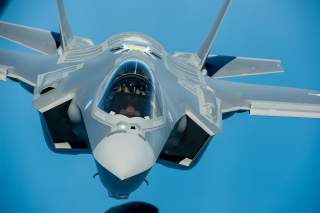This Could Be a Problem: Here's Your Chance to Track an F-35 Stealth Fighter
Not so stealth after all?
Regardless of intent or accident, the Israeli F-35 incident illuminates a problem with stealth aircraft. Flying machines that are designed to minimize detection by radar still need to share airspace with lots of other aircraft in crowded skies, which means that those other aircraft as well as air traffic control needs to know the stealth plane's location. There may be no harm in a stealth aircraft turning on its transponder over friendly airspace. Or then again, there may be good reason why a stealth plane on a mission absolutely needs to keep its location secret.
America has spent a lot of money to make the F-35 stealth fighter invisible to its enemies.
But the F-35 has encountered an enemy that can pierce its stealthy veil: namely, a civilian flight tracker—the kind that tells airline passengers their location during a flight.
(This first appeared last month.)
An Israeli F-35 was tracked by flight tracking site flightradar24, according to aviation Web site The Aviationist.
"On July, 23, an F-35 went fully visible on popular flight tracking website Flightradar24.com as it performed a mission out of Nevatim airbase. The aircraft could be monitored for about 1 hour as it went 'feet wet' (over the sea) north of Gaza then flew northbound to operate near Haifa," the Aviationist said.
The flight tracker even provided details on the aircraft's transponder.
"The F-35 used a US hex code (AF351F, first logged on Nov. 15, 2016 over at Live ModeS and since then regularly tracked in the U.S.) even though it’s safe to believe it could be one of the Adir aircraft delivered to the Israeli Air Force in the last weeks. A hex code is a unique ICAO [International Civil Aviation Organization] 24-bit address assigned to a Mode-S/ADS-B transponder."
At this point, one might wonder why a stealth combat aircraft was operating with its transponder on. One possibility is that it was a deliberate move to let Israel's enemies—notably Syria and Iran—know that Israel's F-35s are out there. Such actions are not unprecedented.
"Increasingly, RC-135s and other strategic ISR [intelligence, surveillance and reconnaissance] platforms, including Global Hawks, operate over highly sensitive regions, such as Ukraine or the Korean Peninsula, with the ADS-B and Mode-S turned on, so that even commercial off the shelf receivers (or public tracking websites) can monitor them," notes the Aviationist.
However, Israel has made no secret that its first F-35I Adir squadron went operational last year, and that the aircraft has already made its combat debut with strikes on Syria earlier this year. So what would be gained by briefly making an aircraft visible on flight trackers?
A simpler explanation is simple error. For example, some NATO aircraft accidentally left their transponders on while flying airstrikes over Libya in 2011, as have U.S. aircraft over Afghanistan and even Air Force One, the Aviationist points out.
Recommended: What Will the Sixth-Generation Jet Fighter Look Like?
Recommended: Imagine a U.S. Air Force That Never Built the B-52 Bomber
Recommended: Russia's Next Big Military Sale - To Mexico?
Regardless of intent or accident, the Israeli F-35 incident illuminates a problem with stealth aircraft. Flying machines that are designed to minimize detection by radar still need to share airspace with lots of other aircraft in crowded skies, which means that those other aircraft as well as air traffic control needs to know the stealth plane's location. There may be no harm in a stealth aircraft turning on its transponder over friendly airspace. Or then again, there may be good reason why a stealth plane on a mission absolutely needs to keep its location secret.
The same applies to drones. An aircraft flying with minimal human control—or no control at all—can be a danger to themselves and other planes, which is why the U.S. government is still struggling with how to let drones fly in national airspace.
Michael Peck is a contributing writer for the National Interest. He can be found on Twitter and Facebook

